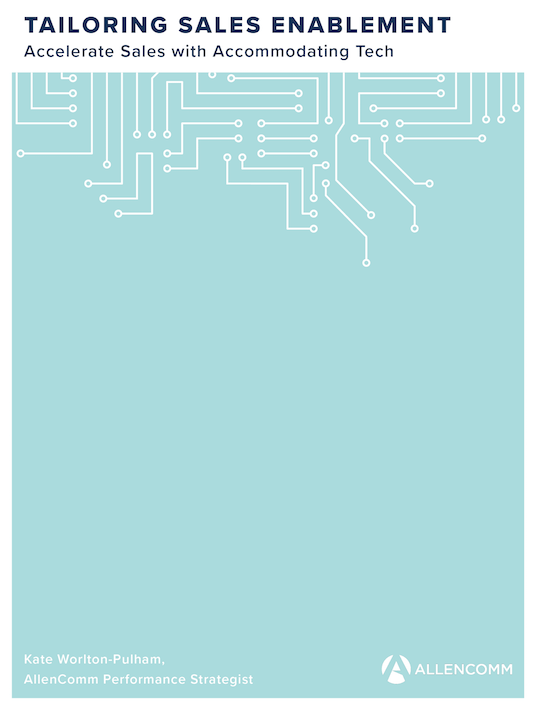What You Need To Know About Evaluating Sales Enablement Assets
Before you read the final part of this article, you might want to check the first part about evaluating the training of sales enablement and the second part about evaluating its technology. Here, we’ll discuss what you need to know about evaluating sales enablement assets.

Up to 70% of product information is found online, not through sales reps. Marketing and sales teams work diligently to create content for many types of selling interactions, but a recent report revealed that two-thirds of the content goes unused [1]. Obviously, the enablement drive needs to deliver deliberate assets from the seller’s hands to the buyer’s hands more resourcefully.
Needs analysis increases revenue by solving common challenges with asset management. A needs analysis ensures effective content usage as it:
- Recommends a centralized content management that is tailored to your organization
- Incorporates scalability
- Establishes robust content findability
- Decreases one-off requests
- Recommends content measurement and reporting intended for your audience
What The Needs Analysis For Your Assets Will Consider
In order to avoid the common points of friction in asset management, an asset needs analysis will evaluate an organization’s context in order to ensure that the assets:
- Are curated for a specific business goal.
- Reflect competitor intel and current industry, company, training, market news, and insights.
- Are proactive and not reactive. For example, a needs analysis of your assets can help manage them so that they anticipate the buyer’s next step in the buying journey and deliver the asset to the buyer before critical decision points, not after it’s too late.
- Are fit for purpose, either existing or newly created. For example, the analysis will consider if the project will be an evolution of their existing assets in the form of an update, or a creation of new assets after identification of gaps in the content inventory.
- Strictly preserve messaging/brand/compliance factors, as necessary.
- Have a support system tailored to the business needs of the buyer that will maximize revenue.
Content Creation And Curation: Sales Enablement Asset Actions And Their Business Impacts
The following asset management actions will accelerate sales by reducing seller inefficiency and increasing buyer win rates. Note their unique business impacts.
Bundle: Maximize Efficiency And Scalability
While each buyer journey will be distinct, sellers will encounter similar combinations of assets for repeated buyer personas. By bundling assets to meet predictable buyer use cases, this feature allows sellers to curate what assets complement each other to benefit different buyer scenarios. Curating reusable asset packages also decreases one-off asset package creation and search time.
For example, an AllenComm client in the manufacturing industry needed the organization of their assets according to buyer persona, especially to help promote the latest offerings to sellers using the platform. According to usage recommendations from the needs analysis, assets were bundled into what they call “briefcases” corresponding with that buyer use case. Bundles serve the buyer best when the search can be dynamic, intuitive, and in-content. When sellers can also buyer-personalize their assets by filtering them by industry, market, buyer stage, stakeholder type, and so forth, the seller discriminates and circulates assets more quickly and ultimately decreases the amount of time to completion of a sale.
Make It Media-Rich: Engage Potential Buyers With Gripping Content
The more formats a solution supports, the easier it is to engage with buyers. The same is true for media variety. Media-rich assets not only incite curiosity in both the seller and the buyer and keep intended topics hard to resist, they, because of their immediacy and digestibility, are also assets that are exponentially sharable. This specialty food provider challenged AllenComm to create assets for sellers who had lackluster value propositions and, hence, low buyer engagement rates. The solution needed to:
- Increase sellers’ confidence in the value they were offering and how to communicate that with magnetic energy.
- Motivate (especially younger) sellers with memorable assets that made it easier to sell.
- Empower the sellers to want to consult with buyers to achieve buyers’ best interests.
Therefore, the solution included informative videos, motion graphics, image-rich job aids, audio interactions, scenario videos, and interactive infographics.
Streamline: Decrease Search Time By Avoiding Sifting Through Superfluous Assets
More than any other action, streamlining assets can accelerate the buyer’s journey by drawing strict priorities among the assets. A needs analysis will target ways to streamline in two ways:
- Excise unnecessary and/or redundant assets.
- Distill information only to what sellers need most for particular buyers.
When we performed an extensive needs analysis for a global auto manufacturer, we found from our focus group interviews, surveys, discussions, and asset investigations that the company had no streamlined asset creation process and no asset management system.
Different divisions, different departments, different teams, were all creating masses of their own assets (unsystematic videos, podcasts, PDFs, infographics, training, slide decks) and we found the assets were largely redundant, off-brand, and not housed in one central location. Different departments were even using different Learning Management Systems for training, something we see often.
Clearly, the action was to streamline the assets into a single repository with assets either removed or restructured into categories by modality, company pillars, training topics, audience, and access recommendations.
Update: Optimize The Assets’ Relevance And, Thereby, The Organization’s Competitive Advantage
Many organizations need content updated constantly, so the solution should support continually changing data while preserving brand integrity. The needs analysis could identify needed updates in tech, product assets, and asset versions.
In the case of one of AllenComm’s global finance clients, it was all three. In addition, because their asset management system had key assets deeply buried inside many misdirected layers of navigation, the project needed to include an update to the design of the repository itself. Their repository could support the sellers much more efficiently if we made the following changes:

The client and its teams now enjoy an accessible repository that they trust is serving up current content, with the brand, messaging, accuracy, footnotes, disclosures, and any other aspects updated and intact. Sellers would benefit from other update features, such as a changelog, easy-to-find insights, shareability to reach the intended audience, notifications on updates to assets, products, language, and strategy.
Fill Gaps: Provide The Potential Buyer With The Content They Need Most
Many companies have a combination of asset curation needs. In the case of a direct retail client, sellers were barraged with multiple versions of assets that lived in several places.
To facilitate a more accurate brand message, we partnered to consolidate the assets to the most updated existing assets in an asset management catalog. After the needs analysis also exposed some performance gaps among their sellers, we identified and helped create needed assets that would bridge these gaps. These new assets were collected in a seller Action Planner that included the sellers’ most frequently used job aids, one-sheets, and reference tools, accessible on mobile devices or as printable PDFs.
Some of the assets were designed to be individualized to each seller, populated in the Action Planner from the seller’s responses throughout their training. Creating assets jointly with the learner/seller, directly populated from the training, means that the information is unique to her different clients, products, and schedules, and strategically designed to grow her business.
Collaborate To Amplify Joint Seller And Buyer Experience
Sales and marketing team members amplify their business if they don’t work in a vacuum. The solution should encourage team members to discuss the assets there in the context of their ongoing projects. Foremost, this interaction should be easy to do. Collaboration should:
- Define and capture best practices.
- Allow teams and coaches to share use cases and insights.
- Give feedback to content creators as to which asset is most useful and when.
Eventually, organizations will be able to identify trends by teams, documents, geographical locations, and stages in the buyer’s process.
Sharing Assets
A needs analysis can reveal the best methods for sharing the assets efficiently, securely, and with optimal benefit. For example, the analysis would consider if sellers have a number of options for sharing content—from email, from the CRM, or from the platform itself, all with an embedded secure content link—to allow for flexibility and to ensure that only the intended audience can view the shared content. These asset management actions are all to ensure the optimal impact on revenue.
If you want to learn more about creating a successful sales enablement program, download the eBook Tailoring Sales Enablement: Accelerate Sales With Accommodating Tech.
Reference:
[1] Summit 2013 Highlights: Inciting a B-to-B Content Revolution









